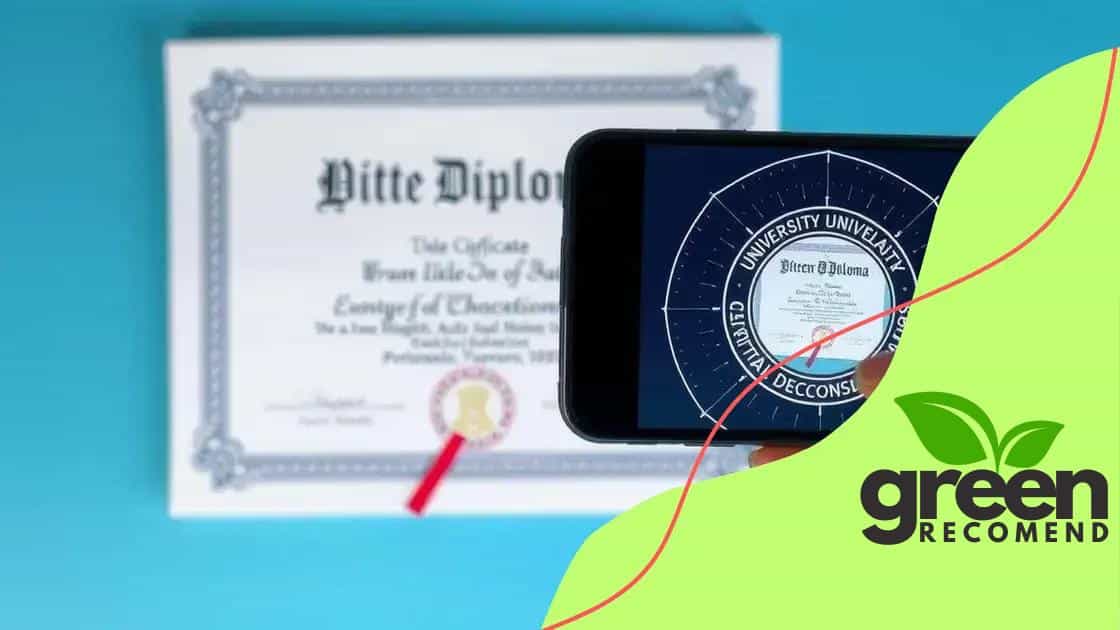Blockchain in verifying academic credentials and certifications

Blockchain is transforming academic credential verification by enhancing security, enabling instant verification, reducing fraud, and providing global recognition of qualifications, thereby streamlining processes for students and employers alike.
Blockchain in verifying academic credentials and certifications represents a breakthrough in how we authenticate educational achievements. This innovative solution not only enhances security but also builds trust in qualifications. Have you considered how this technology could impact future job prospects?
Understanding blockchain technology
Understanding blockchain technology is essential to grasp how it can revolutionize various industries, especially in verifying academic credentials. This innovative system provides a decentralized ledger that enhances security, transparency, and efficiency.
What is Blockchain?
Blockchain is a digital ledger technology that records transactions in a secure and immutable way. Each transaction, or block, is linked to the previous block, forming a chain. This unique structure prevents alterations and ensures that data remains trustworthy.
Key Features of Blockchain Technology
- Decentralization: Unlike traditional databases, blockchain operates across a network of computers, minimizing risks of single-point failures.
- Immutability: Once recorded on the blockchain, data cannot be easily changed or deleted, increasing trust.
- Transparency: Participants can view the entire history of transactions, fostering accountability.
The decentralized nature of blockchain eliminates the need for intermediaries, reducing costs and speeding up processes. For academic institutions, this means that records can be verified quickly and securely.
Moreover, blockchain technology enhances the authenticity of academic credentials. Since each credential can be traced back to its origin, employers can verify a candidate’s qualifications without the risk of fraud.
Applications of Blockchain in Education
Educational institutions implementing blockchain are witnessing improvements in verification processes. Schools can issue tamper-proof diplomas, while employers can efficiently validate these credentials. This innovative approach not only saves time but also builds a stronger reputation for the institution.
As we delve deeper into this technology, it’s clear that understanding blockchain technology is stepping into the future of education and employment verification. The increased security and transparency mean a better experience for students and employers alike.
The role of blockchain in credential verification
The role of blockchain in credential verification is becoming increasingly important. This technology ensures that academic records are secure, credible, and easily accessible.
How Does Blockchain Work in Verification?
When an academic institution issues a credential, it gets recorded on the blockchain. This entry is time-stamped and immutable, meaning that no one can alter the record once it’s created. As a result, employers can trust that the information is genuine.
Benefits of Using Blockchain for Credential Verification
- Increased Security: Data stored on the blockchain is encrypted and secure, reducing the risk of fraud.
- Fast Verification: Employers can quickly verify a candidate’s credentials without waiting for paperwork.
- Accountability: Every transaction is recorded, providing a clear history of the credential’s path.
Incorporating blockchain into credential verification processes doesn’t just simplify operations. It also elevates the standards of educational integrity. Students can share their verified credentials easily and confidently. Imagine applying for a job and knowing that your qualifications are instantly verifiable.
The reliability of blockchain technology promotes trust between students and educational institutions. As schools adopt this technology, it sets a new precedent for how credentials are viewed by employers. This shift can lead to more job opportunities, as employers know they are hiring graduates with verified skills.
Challenges in Implementation
Despite the clear advantages, implementing blockchain systems is not without challenges. Institutions need technical knowledge and infrastructure to support this technology. Moreover, there are concerns about data privacy and compliance with regulations.
As educational institutions navigate these challenges, the benefits of blockchain in credential verification will likely outweigh the hurdles. As a result, students can feel more secure about their achievements while employers can make more informed hiring decisions.
Benefits of blockchain for educational institutions

The benefits of blockchain for educational institutions are increasingly recognized as the technology evolves. By implementing this decentralized system, schools and universities can enhance their operational efficiency and security.
Improved Security and Integrity
One of the primary advantages of blockchain is its ability to secure sensitive data. Academic records are stored in a way that prevents tampering. This means that students’ diplomas and credentials are safe from fraud.
Streamlined Administrative Processes
With **blockchain technology**, many administrative tasks can be automated. This reduces the workload for staff. Processes such as application verification and transcript requests can be handled quicker. Students benefit from faster turnaround times, allowing them to focus on their studies.
- Instant Verification: Employers can check a candidate’s qualifications instantly, reducing hiring times.
- Cost Savings: Less paperwork and fewer errors lead to lower operational costs.
- Decentralized Management: Institutions can manage records without relying on a central authority.
Another major benefit is the trust blockchain brings to the education system. Students and employers can have greater confidence in the authenticity of academic achievements. When records are easily verifiable, institutions can attract more students and bolster their reputation.
Furthermore, as education becomes increasingly global, blockchain helps facilitate international recognition of credentials. Students studying abroad can carry their verified records with ease. This opens doors to global job markets, enhancing opportunities for graduates.
Innovation in Learning
Educational institutions using blockchain are also fostering innovation in learning processes. They can track student progress more effectively and tailor educational experiences based on data. With insights gained from blockchain, schools can make informed decisions to improve curricula.
By embracing blockchain technology, educational institutions are not just staying relevant; they are paving the way for the future of education.
Challenges in implementing blockchain solutions
Implementing blockchain solutions comes with a unique set of challenges that educational institutions must navigate. While the technology offers significant benefits, the road to adoption is not always smooth.
Technical Complexity
One of the main challenges is the technical complexity involved in setting up blockchain systems. Many educational institutions may lack the necessary technical expertise to develop and maintain these systems. This can lead to delays in adoption and increased costs.
Data Privacy Concerns
Another significant concern is data privacy. As students’ academic records are stored on a decentralized network, ensuring that sensitive information is protected is crucial. Institutions must navigate regulations and ensure compliance with laws like GDPR.
- Secure Data Handling: Educational institutions need to implement secure practices to protect student data.
- Compliance Challenges: Adhering to legal standards can be complex and varies by region.
- Keeping Data Anonymous: It’s essential to ensure that personal information remains confidential while using blockchain.
Furthermore, the initial investment required to implement blockchain solutions can be daunting for many institutions. This encompasses costs related to technology, training staff, and maintaining the system over time. Such financial barriers may slow down the adoption of innovative technologies.
Another challenge is the resistance to change. Many educational institutions have established processes that may not easily align with the new systems. Staff and administrators may need training and support to adapt to blockchain technology fully.
Integration with Existing Systems
Integrating blockchain with existing infrastructure can also be complicated. Older systems may not be compatible with new technologies, leading to integration issues. Continuous support is necessary to ensure that both systems work harmoniously.
Despite these challenges, many institutions recognize the potential of blockchain solutions in transforming education. With careful planning and commitment, they can overcome barriers and harness the advantages of this innovative technology.
Future of blockchain in education sector
The future of blockchain in the education sector looks promising and innovative. As more institutions explore this technology, its potential to transform how education operates becomes clearer.
Increased Adoption
In the coming years, we can expect an increase in the adoption of blockchain solutions in schools and universities. The clear benefits, such as enhanced security and efficient credential verification, make it an appealing choice for many educational institutions.
Enhanced Learning Experiences
Blockchain technology can also facilitate personalized learning experiences. By tracking student achievements and engagement, educators can tailor their teaching methods to meet individual needs. This could help students learn more effectively and improve overall educational outcomes.
- Innovative Educational Programs: Schools may implement programs that utilize blockchain for decentralized learning paths.
- Collaboration Opportunities: Shared access to courses and materials on a secure platform could foster collaboration among institutions.
- Global Recognition of Credentials: Graduates can showcase verified credentials globally, making it easier to enter the job market.
Furthermore, as technology becomes more integrated into education, digital literacy will increasingly include knowledge of blockchain. Students may learn about this technology as part of their curriculum, preparing them for future job opportunities where blockchain skills are in demand.
Partnerships between educational institutions and technology companies are likely to thrive as they work together to harness the power of blockchain. These partnerships can lead to new tools and resources that enhance the overall educational experience.
Ongoing Research and Development
Research into the applications of blockchain in education will continue to advance. Studies may focus on its impact on educational equity, accessibility, and efficiency. As research evolves, so will the frameworks that support its implementation in schools.
Educational institutions that embrace the future of blockchain technology will not only enhance their operational capabilities but also support student success and prepare for a more dynamic workforce.
blockchain technology has the potential to greatly transform the education sector. Its benefits include enhanced security, streamlined processes, and increased trust in academic credentials. As more institutions embrace blockchain solutions, we can expect to see improved learning experiences and better career opportunities for graduates. Educational institutions that successfully implement this technology will not only meet the needs of today’s learners but will also prepare for a more innovative future.
FAQ – Frequently Asked Questions about Blockchain in Education
How does blockchain increase security in academic records?
Blockchain uses encryption and a decentralized ledger to ensure that academic records cannot be tampered with, thus ensuring their authenticity.
What are the benefits of using blockchain for credential verification?
Blockchain allows for instant verification of credentials, reduces fraud, and saves time for both students and employers.
What challenges do educational institutions face when implementing blockchain?
Challenges include technical complexity, data privacy concerns, and the need for staff training to adapt to new systems.
What is the future of blockchain technology in education?
The future looks promising with increased adoption, enhanced learning experiences, and the potential for global recognition of credentials.





